Environmental, Social and Governance or known as ESG has become one of the hottest topics in the last few years. Raging wildfires in Australia and California, floods in New York, melting icebergs in Greenland (if Titanic was made today, it probably won’t find any icebergs to hit) and our one and only Greta Thunberg have really opened our eyes to climate change. That’s why the whole world carefully watched the United Nations Climate Change Conference a.k.a. COP26 unfolded in the Scottish capital.
First day at COP26
Kaushal (our CEO) and I jumped on our 5 hour long train ride to Glasgow with two small bags. We avoided taking a flight, congruent to our pledge of always choosing the most sustainable transport option. We finally arrived in Glasgow around 5 pm. As we walked out of the station, we realised that COP26 had engulfed the whole of Glasgow. Every window had COP26 stickers, there were dedicated busses for COP26 and almost everyone on the street were wearing their COP26 badges. The city was really well prepared to welcome the 120 world leaders and thousands of visitors.
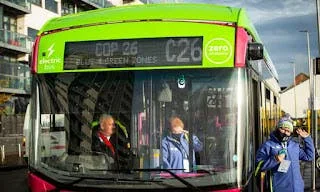
The first event we went to was hosted by the B Corporation. B Corp is a non-profit organisation that certifies the most socially and environmentally well performing for-profit companies. That means, you can totally count on the diversity and the range of B Corp members.
As I got introduced to our fellow B Corp companies, I was reminded that technology has enabled so many new innovations and vehicles to be socially responsible. There were so many companies with innovative and interesting solutions to tackle climate change, from breweries that made beer from surplus bread to carbon-negative cement alternatives! Some of the best examples of sustainability and technology going hand in hand.
Another fun idea the B Corp implemented in their event was carbon-mindful drinking. Did you know G&T is more environmentally friendly than a pint of beer? And that a pint of beer is more sustainable than a bottle of beer?
Next time you stop for a drink, please try to buy local and look for that B Corp certification!
Second day at COP26
Kaushal (our CEO) and I jumped on our 5 hour long train ride to Glasgow with two small bags. We avoided taking a flight, congruent to our pledge of always choosing the most sustainable transport option. We finally arrived in Glasgow around 5 pm. As we walked out of the station, we realised that COP26 had engulfed the whole of Glasgow. Every window had COP26 stickers, there were dedicated busses for COP26 and almost everyone on the street were wearing their COP26 badges. The city was really well prepared to welcome the 120 world leaders and thousands of visitors.

Kaushal attended the much anticipated discussion titled ‘Climate justice, education and gender equality: Targeting the connections’, organised by the Malala fund. Kicked off by Scottish First Minister Nicola Sturgeon, who spoke about how they are collaborating with International organisations that help direct Scottish funds to revitalise the education systems in developing nations. The key message of this session was the need to make and keep education accessible, even in the face of events like the pandemic. There was a special focus on how such events impede the education of girls, especially in the developing world, where they are made to stay home and contribute towards running the household.
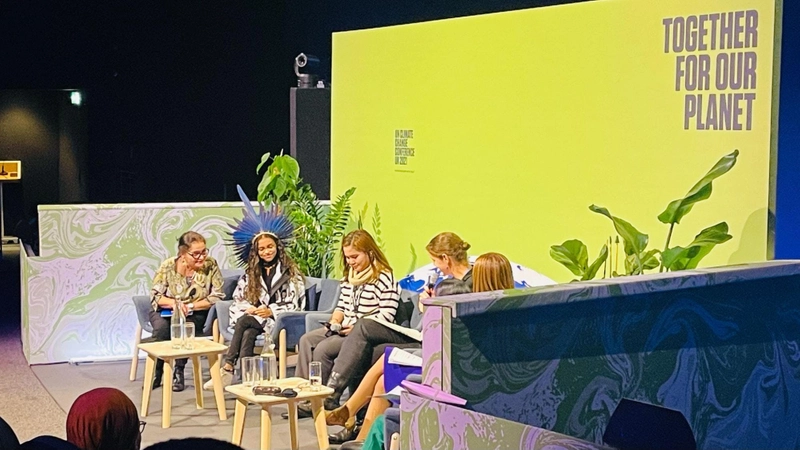
Following that, there was a panel discussion discussing how National Governments can collaborate better with local authorities to develop and deliver effective strategies to combat the effects of climate change. Invited all the way from Bangladesh was prominent politician Tanvir Shakil Joy who reiterated that even a 1 meter rise in sea levels could submerge about 30% of his country, displacing more than 20 Million people. A country that has one of the lowest carbon footprints on the planet, will have to pay a disproportionate price for our collective failure/inaction. MP Werani Chilenga from Malawi reminded COP26 about the $100 Billion commitment made at the last COP to help under-developed nations and how the funds weren’t reaching their intended destinations due to mismanagement. As the event drew to a close, the air was mixed with feelings of optimism and cynicism at the same time.
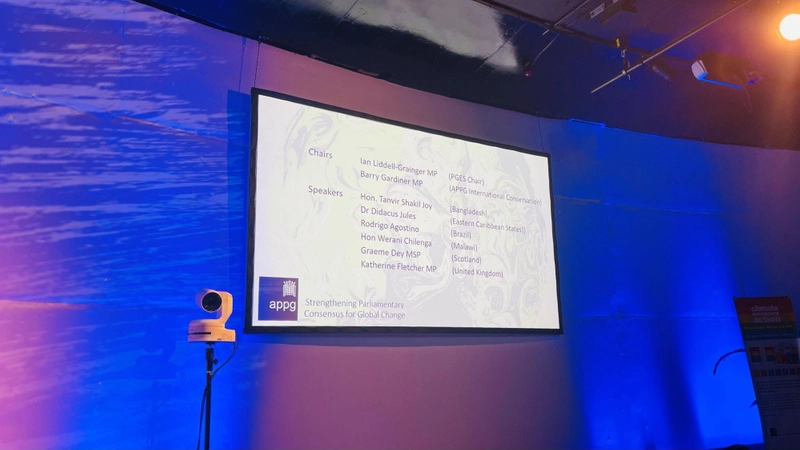
I attended the ‘Global Day of Action for Climate Justice’ at Kelvingrove Park in western part of Glasgow. This is where Greta Thunberg and thousands of others decided that entrusting our future in the hands of politicians was not enough. 100,000 people, from all around the world, came to Glasgow to demand more action on climate change from world leaders.

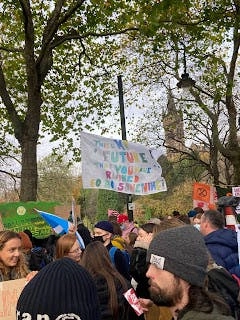
The “Global Day of Action for Climate Justice” was the largest environmental protest so far. Thousands chanted “System change, not climate change”. Amongst them, thousands of children and teenagers were marching in protest of government inaction on climate change.
How can we, as adults, ignore climate change when 5 year olds can understand the significance of it?
The UK Education Secretary Nadhim Zahawi urged children not to miss school to protest. In response, the children marching said the government wasn’t not doing enough to protect their future on our planet.
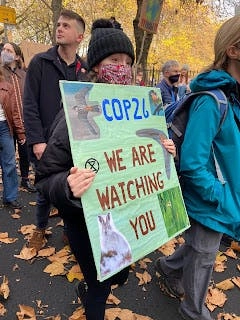

After 4 hours of marching, I headed to an Extreme Hangout event to attend a panel called “Future where art and science combine and collide”. Panelists included talented songwriter Beatie Wolfe, an appointed UN Women role model for innovation and Love Ssega (Ssegawa-Ssekintu Kiwanuka), a British-Ugandan musician, producer and climate activist. The topic was very relevant to today’s climate where we, as residents of developed countries, are obliged to communicate the significance and the urgency of climate change to third world countries and developing countries where living standards are so low that survival is still a day-to-day struggle. The panelists discussed how the most effective and efficient way to do so is through art. Art is an expression of emotion, therefore it is increasingly seen as “a powerful way of developing a meaningful connection with climate change” (Bentz and O’Brien 2019; Shrivastava et al. 2012). Artistic and creative practices and approaches can help expand our limits of imagination and therefore help us to think outside the box.
With so much inspiration from the Extreme Hangout, I headed to Goals House for a reception hosted by Amazon for its Climate Pledge signatories, where Kaushal joined me.. The Goals House are sustainable sanctuaries, designed to host ground-breaking debate and discussions that lead to action in order to reach the targets of the Global Goals (SDGs).
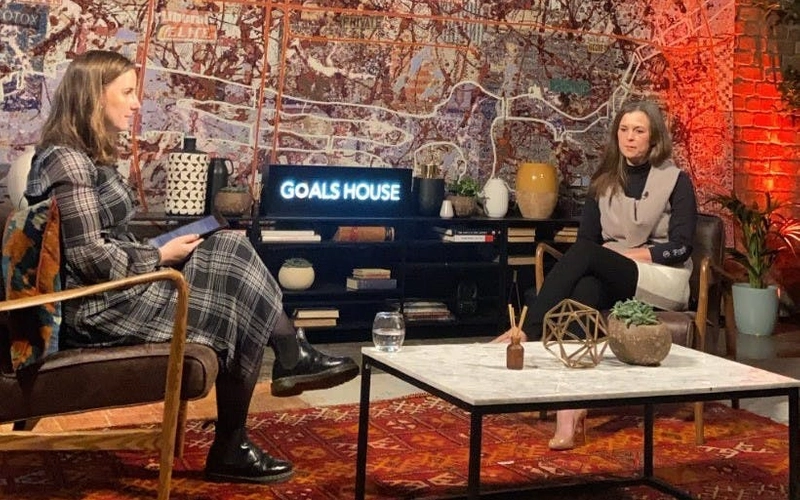
There we met 200 other fellow-signatory companies that pledged to go carbon-neutral with Amazon. It was encouraging to see so many companies from all around the world, pledging to go net-zero carbon by 2040, a decade ahead of the Paris Agreement target. Also, many influential and inspiring speakers were there to share their knowledge and expertise in the ESG field. And one of those people was Joanna Allen, CEO, Graze, Part of The Better Business Act. She talked about the importance of aligning shareholders interest with those of wider society and the environment. She also highlighted the significant role the legislation plays in climate change. Once again, we were reminded that we can only tackle climate change through cooperation. Joint cooperation from governments, NGO’s, businesses and individuals like us.
After a highly eventful and educational day, having a three-course meal with a glass of good wine at the Goals House marked the perfect end to my first COP.








